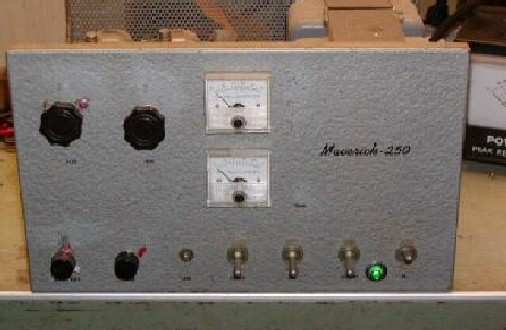

This is the D&A model Maverick 250 amplifier. This unit was a two stage amp, with an advertised power output of 250 watts AM and 750 watts PEP on SSB. Over the course of time, D&A changed the appearance and some aspects of the design. The unit pictured above was an example of the "old" version which sported a gray colored cabinet. They also made a newer version which came in a two tone tan and brown cabinet. The newer version was designed (in an attempt to skirt the FCC's tougher amp regulations) as a ham radio "transmitter" and had a crystal socket on the front panel, while the former R.F. input jack was labeled "VFO" yet was curiously still an SO-239 style jack (hmmmm). I have to wonder if anyone ever used it as a transmitter.... Anyway, other than this, the biggest differences between the old and new models was the fact that the old model had 4 driver tubes, and 4 output tubes, while the newer version only had 3 driver tubes. The tube compliment consisted of 4 6LQ6 tubes in the output side, with either 3 or 4 6JG6 types on the driver side.
The Maverick 250 featured twin Load and Plate tune controls for both the driver and the output stages, a separate output meter for high and low power settings, and switches for a Receiver amp, Hi/Lo power, Standby, and Power on. This amp also had a built-in cooling fan and twin heavy duty power transformers (which made this a pretty heavy door stop). Like the Raider, the receive amp rarely worked properly (if at all), leaving me to wonder just what kind of last minute engineering went into the receive amp.
There were a couple of the older versions of the Maverick floating around my local area, including those owned by Diesel Doctor, and Jolly Roger. I ended up becoming the owner of one of the newer versions sometime around 1981. I don't remember the specifics of the deal (And there WAS a deal, trust me), but I soon had what would be the most power that I would ever run from my base station. This amp would run about 150 watts on the low side and about 300 on the high side, and about 650 or so on SSB. Even as much as this thing catapulted my signal over any previous level, I was still never the kind of person who could just leave well enough alone, so consequently I was always trying to squeak a little more power out of it. Once I tried swapping out the driver tubes for stronger 6LQ6 types. I started loading it up and I became excited when my wattmeter started climbing above the 400 watt mark. Back and forth I would tune and the meter would creep ever so slightly higher; 400, 450, 500. Finally I was peaking yet another time and briefly saw the wattmeter hit 600 watts, when there was a simultaneous flash along with the lights and the power to my room going out. I had blown the 15 amp A.C. house fuse. But that was not all. When I restored power, I fired up the amp and found that it wouldn't make more than about 10 watts of power. Further investigation revealed that I had smoked all 7 tubes. Fortunately I had replacements, and then dummy me tried it again with the same result. After I smoked the next set of tubes, I decided that maybe I should put things back to the stock configuration. I still don't fully understand what had happened. I can understand that the increased power of the hotter driver tubes might have overdriven the output tubes and killed them, but why did the driver tubes fry too? It's possible that the whole thing took off into oscillation, and those high wattmeter readings were the result of spurious emissions. I guess I'll never know, since I eventually traded the amp for a homebrew 813 tube ham "kilowatt". That amp never did what it should have done (or more accurately what I thought it was supposed to do). I should have kept the Maverick. But at today's tube prices, I'd be a little more restrained when it came to experimenting.